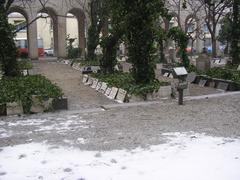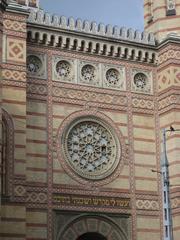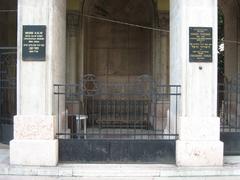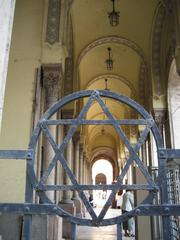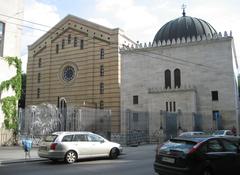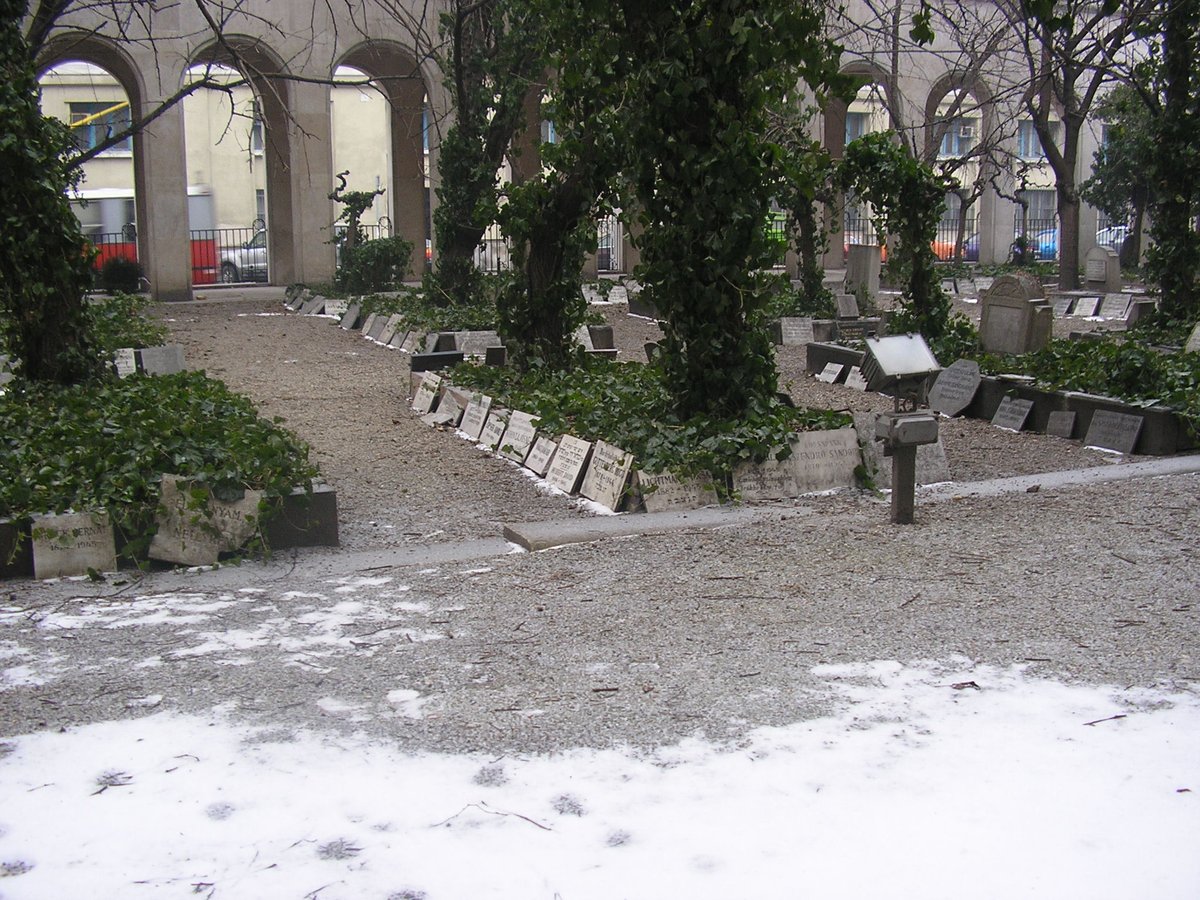
Dohány Street Synagogue: Visiting Hours, Tickets, and a Guide to Budapest’s Iconic Jewish Landmark
Date: 14/06/2025
Introduction
Nestled in Budapest’s vibrant Jewish Quarter, the Dohány Street Synagogue—also known as the Great Synagogue or Nagy zsinagóga—stands as Europe’s largest synagogue and one of the city’s most significant historical sites. Constructed between 1854 and 1859, its Moorish Revival design, cultural prominence, and poignant Holocaust memorials make it a compelling destination for travelers, historians, and architecture enthusiasts alike (Hungarian Jewish Museum and Archives; Wikipedia).
This guide offers a comprehensive overview of the synagogue’s origins, architectural highlights, historical significance, and practical visitor information—including Dohány Street Synagogue visiting hours, ticketing details, accessibility, and nearby attractions.
Table of Contents
- Introduction
- Historical Background
- Architectural Significance
- The Synagogue Complex: Components and Memorials
- Dohány Street Synagogue in Jewish and Hungarian History
- Planning Your Visit
- Visual Media
- Frequently Asked Questions (FAQ)
- Conclusion and Visitor Recommendations
- References
Historical Background
The Dohány Street Synagogue was conceived by the burgeoning Pest Jewish community in the mid-19th century, a time of social reform and Jewish emancipation. The community commissioned Viennese architect Ludwig Förster, who won a design competition with his vision for a grand, monumental synagogue reflecting the aspirations and growing confidence of Hungarian Jews (Hungarian Jewish Museum and Archives; History Hit).
The edifice was inaugurated in 1859 and became a centerpiece for the Neolog movement—a branch of Judaism seeking to harmonize religious tradition with modern European culture (Hungary Unlocked).
Architectural Significance
The synagogue’s Moorish Revival style, selected by Förster, draws heavily on North African and Spanish Islamic motifs, notably the Alhambra, and sets the building apart from Christian ecclesiastical architecture (Wikipedia).
Key features include:
- Twin octagonal towers (43 meters tall) capped by onion domes, dominating the Budapest skyline.
- Alternating red and yellow brickwork and a rose window above the main entrance, creating a visually dynamic façade.
- Interior grandeur: A basilican layout with a central nave, side aisles, and balconies, supporting a capacity of up to 3,000 worshippers (The Better Vacation).
- Ornamentation: Gilded stars on a deep blue ceiling, intricate arabesques, cast-iron columns, and an elaborate Ark (Aron Kodesh) with stained glass windows.
- Organ: An unusual feature for synagogues, reflecting the Neolog tradition’s progressive influence (yourcitybudapest.com).
The Synagogue Complex: Components and Memorials
The Dohány Street Synagogue is the centerpiece of a multifaceted complex:
The Great Synagogue
The main house of worship, celebrated for its scale and Moorish-Byzantine artistry.
The Heroes’ Temple
A domed annex built in 1931 to honor Hungarian Jewish soldiers who fell in World War I (Hungarian Conservative).
Hungarian Jewish Museum and Archives
Adjacent to the synagogue, situated on the site of Theodor Herzl’s birthplace, this museum houses an extensive collection of artifacts and exhibits on Hungarian Jewish life (BudAPPest).
Holocaust Memorials
The complex includes emotionally resonant memorials:
- Raoul Wallenberg Memorial Park: Honoring the Swedish diplomat who saved thousands of Hungarian Jews.
- The Tree of Life: A weeping willow sculpture by Imre Varga, each leaf inscribed with the name of a Holocaust victim.
- Cemetery: Unusually located within the synagogue grounds, where thousands of Holocaust victims are buried (The Better Vacation).
Dohány Street Synagogue in Jewish and Hungarian History
Pre-World War II
By the early 20th century, Budapest’s Jewish community was one of Europe’s largest and most influential, accounting for nearly a quarter of the city’s population (A City a Month). The synagogue was both a religious and cultural center, embodying the integration and vibrancy of Jewish life in Hungary.
The Holocaust and World War II
During the Nazi occupation, Dohány Street marked the boundary of the Budapest Ghetto. The synagogue was bombed, used as a shelter, stable, and radio base, and the area became a site of immense suffering and loss (History Hit; Wikipedia).
Postwar, it became a place of mourning and remembrance, as well as a symbol of resilience and renewal.
Planning Your Visit
Visiting Hours
- May to September: 10:00 AM – 8:00 PM
- October to April: 10:00 AM – 4:00 PM (subject to change)
- Closed: Saturdays and major Jewish holidays
Always check the official Dohány Street Synagogue website for the latest updates before visiting.
Ticketing and Admission
- Adult tickets: 13,000 HUF (~€31)
- Students: 10,500 HUF (~€25.50)
- Children under 6: Free
- Ticket includes: Access to the synagogue, museum, Heroes’ Temple, cemetery, memorial park, and guided tour (Time Out Budapest; All Things Budapest).
Tickets can be purchased online for faster entry or at the on-site ticket office.
Guided Tours
- Mandatory and included in ticket
- Languages: English, German, French, Italian, Spanish, Russian, Polish, Hebrew, Hungarian
- Duration: 1–1.5 hours
- Explains the history, architecture, and significance of the synagogue and its memorials.
Accessibility
- The main prayer hall, museum, and Heroes’ Temple are wheelchair accessible.
- Some areas (like the upper galleries) may have limited access.
- Ramps and assistance are available; contact the site in advance for specific needs (All Things Budapest).
Travel Tips
- Dress code: Modest attire required. Men must wear a kippah (provided at the entrance).
- Photography: Permitted in most areas (no flash, no tripods). Respect signage in sensitive areas.
- Getting there: Located at Dohány utca 2, 1074 Budapest. Nearest metro: Astoria (M2). Tram lines 47/49 and several bus routes stop nearby.
- Nearby attractions: Explore the Jewish Quarter’s cafés, kosher restaurants, Kazinczy Street Synagogue, and Hungarian National Museum.
Visual Media
High-quality images and virtual tours showcasing the synagogue’s architecture, interiors, and memorials are available on the official website and museum resources.
Frequently Asked Questions (FAQ)
Q: What are the Dohány Street Synagogue’s visiting hours?
A: Typically from 10:00 AM to 8:00 PM in summer, 10:00 AM to 4:00 PM in winter. Closed on Saturdays and Jewish holidays.
Q: Are guided tours required?
A: Yes, all visits are part of a guided tour included in the ticket.
Q: Is the synagogue wheelchair accessible?
A: Yes, main areas are accessible, though some galleries may not be.
Q: Is photography allowed?
A: Yes, except during services and in certain memorial areas. No flash or tripods.
Q: How long should I plan for my visit?
A: Allow 1.5 to 2 hours for a thorough visit.
Q: Can I buy tickets in advance?
A: Yes, online purchase is recommended to avoid queues.
Q: Are there events and concerts?
A: Yes, check the official website for information on concerts and special events featuring the historic pipe organ.
Conclusion and Visitor Recommendations
The Dohány Street Synagogue is not just a masterwork of architecture—it is a living testament to Budapest’s Jewish community, its endurance through tragedy, and its ongoing cultural vibrancy. Visitors will find a site that blends spiritual, historical, and educational experiences in an unforgettable setting.
To make the most of your visit:
- Check current Dohány Street Synagogue visiting hours and ticket prices.
- Dress modestly and allow sufficient time for the tour and memorials.
- Explore the surrounding Jewish Quarter to deepen your understanding of Budapest’s Jewish heritage. For enhanced experiences, download the Audiala app for audio tours and event updates, and follow official channels for the latest news.
References
- Hungarian Jewish Museum and Archives
- Wikipedia
- History Hit
- Hungary Unlocked
- The Better Vacation
- BudAPPest
- Hungarian Conservative
- yourcitybudapest.com
- All Things Budapest
- Time Out Budapest
- Questo App
- A City a Month
